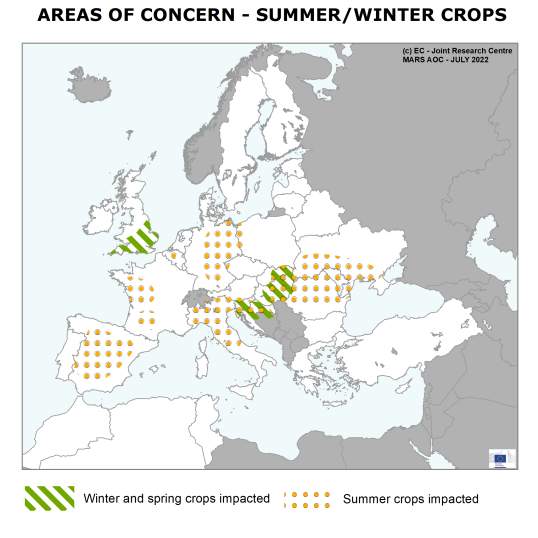Hot and dry weather conditions take their toll
According to the July issue of the JRC MARS Bulletin – Crop monitoring in Europe, published today, the yield outlook for EU summer crops was substantially reduced due to continued hot and/or dry weather conditions in large parts of Europe. The most pronounced reductions (by 8 to 9% at EU level) are for grain maize, sunflowers and soybeans, for which the yield forecasts are now well below the 5-year average. The forecasts for winter crops – which are reaching the end of the season – were subject to minor changes at EU level, remaining close to the 5-year average.

Extremely hot and dry conditions in several regions of Europe
The review period was marked by extremely hot and dry conditions in several regions of Europe. Negative impacts on the yield potential of summer crops are most pronounced in regions that were already affected by long-lasting rain deficits, such as large parts of Spain, southern France, central and northern Italy, central Germany, northern Romania, eastern Hungary, and western and southern Ukraine. Apart from direct impacts on growth, drought and heat stress in several regions coincided with the flowering stage, resulting in reduced flower fertility. Moreover, in several of the regions where summer crops rely on irrigation, the very low levels of water reservoirs are insufficient to meet demand.

We need your help: JRC MARS Bulletins Survey
The JRC MARS Bulletins Survey aims to collect information to better understand how you use the JRC MARS Bulletin. This will help us to improve our service in the future. Completion of the survey should take less than 10 minutes of your time. All information collected will be anonymous – no personal information is requested.
The survey is available at 2022 JRC MARS Bulletin – Crop Monitoring in Europe Survey
Further information
JRC MARS (Monitoring Agricultural Resources) Bulletins
The latest information about global agricultural production hotspots for countries at risk of food insecurity is available on the JRC’s ASAP (Anomaly hot Spots of Agricultural Production) site.
O artigo foi publicado originalmente em JRC.























































